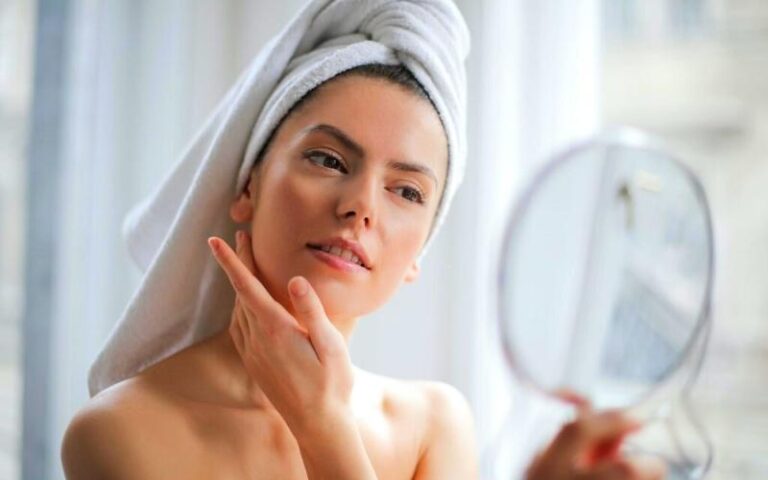Uneven Skin On Legs: Causes, Home Remedies, and Tips

Most people want long, lean, toned legs and share the same frustrations that no amount of waxing, sunbathing, or squats can guarantee flawless legs. Uneven skin on legs may be genetic or inherited but environmental factors play a major role causing freckles and sunspots on legs.
Do not worry! We got you covered! Here we have come up with certain DIY’s and tips that could help you achieve an even skin tone on legs naturally.
Causes Of Uneven Skin Tone On Legs
Uneven skin tone or discolorations on the legs can occur for various reasons. Some causes may be temporary and clear up with time, but others may require long-term treatment.
Razor Burns
Razor burns can occur due to improper shaving, dry shaving (without using shaving cream or gel, water, or soap), using dull old razors, shaving too fast, or shaving against the direction of the hair growth. It can lead to tiny cuts and scrapes on the skin, razor bumps, inflammation, patches of redness, blotchy rashes, and red spots.
Ingrown Hairs
Tiny hair follicles bend and grow back into the skin, resulting in ingrown hairs. People with coarse or curly hair may get ingrown hairs more frequently. In some people, this most likely occurs due to waxing, shaving, or tweezing. An inflammatory lump develops, which can be both unpleasant and ugly.
Ingrown hairs tend to grow in areas with a lot of friction.
Clogged Pores
Your skin will naturally create more oil when the pores on the skin of your legs are blocked. The oil oxidizes and turns black when it comes into contact with air after shaving and opening your pores. It results in tiny black or red spots. Unevenness from clogged pores is more likely to occur in people with thicker hair or larger pores. Additionally, clogged pores are more noticeable if your skin is lighter.
Dry Skin
Although very dry skin cannot create unevenness on your legs, it certainly increases your risk. Dry skin is more prone to razor burn and irritation since it tends to be more sensitive. Folliculitis and the appearance of darker pores may result from this.
Folliculitis
The skin’s hair follicles can become inflamed and lead to folliculitis. Normally, it appears as a few little red bumps, but they might deepen and start to resemble strawberry legs. The hair follicle is damaged, allowing dirt and bacteria to enter, which results in folliculitis. Wearing restrictive clothing, waxing, shaving, or touching the skin can all result in this injury.
Folliculitis is frequently seen after using a hot tub and exercising, especially in occluded areas where your skin is covered by a bathing or swimming suit. Because our skin is more vulnerable to injury when wet, any regions of the skin covered by your swimsuit are at risk for developing folliculitis.
Excessive Sun Exposure
Frequent or unprotected sun exposure can lead to sunspots. Sun spots on your skin can substantially alter the appearance of your skin.
Too much exposure to the sun can also cause permanent changes in the small blood vessels, leading to patchy reddish appearances on the skin.
Birthmarks
Birthmarks mostly appear at birth. These can be flat or raised, vary in color from white to brown to black to blue to gray, and vary in size from a small pinhead to covering a larger area on the skin. Birthmarks grow as the person grows and is usually harmless.
Skin Disorders
- Eczema: This condition causes skin irritations and inflammations due to allergen exposures, overactive immune systems, or environmental triggers. People with eczema will have skin dryness, roughness, crusting, patchy discolorations, etc.
- Psoriasis: An autoimmune/inflammatory disease in which the skin produces skin cells more rapidly than usual, leading to a buildup of cells on the skin. One can see scaly plaques on the body – scalp, knees, elbows, legs.
- Vitiligo: This condition causes patches of depigmentation on the skin, such as patches of white or light skin around the eyebrows, mouth, elbows, legs, scalp, and anywhere on the body.
- Skin Cancer: Skin cancers can manifest as scaly plaques, skin-colored or newly developed pigmented bumps, pre-existing moles, nevi, or birthmarks that change in hue, size, or shape.
- Venous Insufficiency: Leg vein obstruction that prevents blood from returning to the heart is known as venous insufficiency. The valves in your veins normally ensure that blood travels in the direction of your heart. Blood can also flow backward when these valves aren’t functioning properly. Your legs may start to pool with blood as a result of this. Individuals with this condition will generally have varicose veins, ulcers, swelling, and skin changes in certain areas of the legs.
Natural Ingredients To Even Out Your Leg Skin Tone
Many natural ingredients like turmeric can help you get your leg skin back in time.
- Aloe Vera: Aloe vera gel is excellent for your skin since it evens out the tone of your skin and helps to lessen blemishes. Use a homemade aloe vera gel mask on your legs at least twice a week.
- Licorice Root Extract: The anti-irritant, anti-inflammatory, and skin brightening properties help calm skin sensitivity and reduce hyperpigmentation. It aids in naturally lightening the skin tone.
- Sophora Root: Some compounds isolated from sophora have been found to help even skin tone. Sophora root has been long used in traditional therapies.
- Alpha-Arbutin: This ingredient is used in many serum products to brighten the dark spots or areas due to sun damage and hyperpigmentation. It evens out skin tone without changing the skin color.
- Kiwi Fruit Extract: The exfoliating properties in kiwi fruit extract minimize dark spots, blemishes, and hyperpigmentation, leading to even skin tone.
Home Remedies/DIYs For Getting Even Skin Tone On Legs
You can make your do-it-yourself home remedies to minimize the appearance of uneven skin tone and also use these remedies as a preventative measure for hyperpigmentation or skin texture difficulties. Making exfoliants, rinses, and toners at home with common items is one of the most often used techniques for balancing skin tone and texture on your legs.
Most frequently used at-home skin tone corrections include:
Apple Cider Vinegar
After cleansing the skin, a small amount of apple cider vinegar acts as a very efficient toner, dark spot corrector, and anti-inflammatory and antibacterial remedy. Additionally, it can balance out your face’s tone and texture, unclog and tighten pores, turn dull skin into luminous skin, and help prevent acne.
Baking Soda
Baking soda can be used as an exfoliator. Spread the baking soda paste evenly on your legs, gently scrub it to remove the dead skin cells, wait for a few minutes, and then rinse with warm water. Repeat this process a few times to even out your skin tone.
Yogurt
Yogurt has natural bleaching agents to effectively improve skin tone and exfoliate it. This mask can lighten your suntan, scars, and uneven pigmentation.
Sugar and Olive Oil Scrub
Sugar works great as an exfoliator, and olive oil works as a moisturizer. When combined, a scrub that can get rid of dead skin cells and balance skin texture and tone is produced. Combine one teaspoon of sugar and one teaspoon of olive oil to form the scrub, then massage it all over the face.
Massage for a few minutes before washing with warm water. Depending on your tastes, you can substitute coconut oil for olive oil or add a little additional lemon juice to help brighten your complexion.
Tips For Maintaining Even Skin Tone On Legs
- Moisturize your legs often.
- Exfoliate your skin twice a week.
- Change your shaving habits. Use clean, sharp razors and change the blades every few shaves.
- Use sunscreens every day to protect your skin from sun damage.
- Try to cover your legs by wearing full pants.
- Use natural remedies to boost skin health.
- Eat healthily and avoid allergy and acne-causing foods.
- Drink loads of water to hydrate your skin and enhance skin health and appearance.
- Regular leg stretches can improve blood circulation and keep the skin healthy.
You can use a variety of at-home therapies, such as behavioral modifications and natural medicines, to level out your skin tone.
Make an appointment immediately if you see any imperfections or unevenness that an underlying condition might bring.
FAQs
Q: Can you use foundation on your legs to cover uneven skin tone?
A: No, it is not a good idea to use foundation on legs. The skin on your leg is thicker than the skin on your face. So, you cannot expect a long-lasting result. At the same time, you can use self-tanner or tinted body lotions to cover this uneven tone.
Q: When to consult a doctor if you have uneven skin tone on your legs?
A: If you are unsure of the cause or feel itching, burning, pain, and swelling on these uneven marks, consult a doctor or a dermatologist for an evaluation. They can help you find the real cause and recommend the appropriate treatment.
References
- Uneven Skin Tone/Texture: https://aedit.com/concern/uneven-skin-tonetexture
- Causes and treatments: https://www.medicalnewstoday.com/articles/skin-discoloration-on-legs
- Razor Burn: https://my.clevelandclinic.org/health/diseases/23583-razor-burn
- Natural Ingredients for Even Skin Tone: https://www.annmariegianni.com/10-natural-ingredients-help-even-skin-tone/





